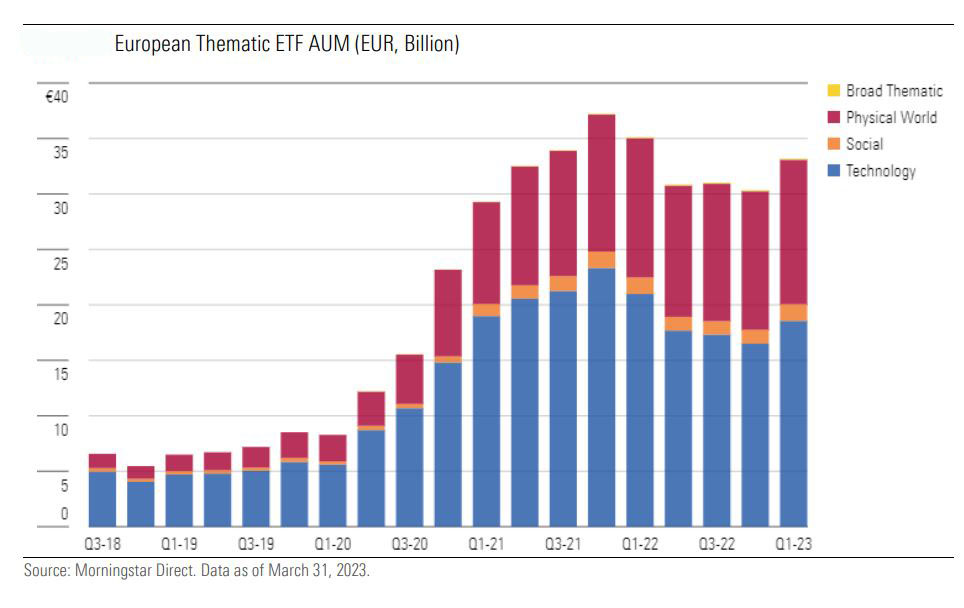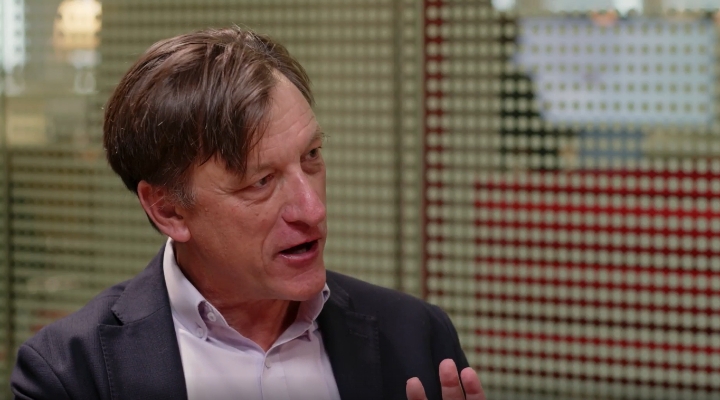
The global market for thematic funds has expanded rapidly in recent years. These funds, often overhyped and sometimes misunderstood, attempt to harness secular growth themes ranging from demographic shifts to the rise of the metaverse. Some have delivered bursts of eye-catching performance, while others have failed to gain traction. As assets have poured into these funds, asset managers around the globe have ramped up the supply of these niche and often gimmicky funds.
But is only in the last five years that we have seen thematic funds seriously attract assets on a global level, with the growth registered in the wake of the global pandemic being nothing short of spectacular. Thematic funds have tripled their share of global equity fund assets to in the 10 years to mid-2022.
Here are three reasons why:
1) Companies with exposure to certain, potentially world-changing, winner-take-all technologies have benefited from rapid growth and soaring stock prices.
2) The "metabolic rate" of the economy may be accelerating, with industry dynamics evolving faster than ever and profit pools shifting across value chains in many industries.
3) Steady improvements in the quality and granularity of financial data mean that highly targeted indexes and investment strategies can now be constructed and maintained. The democratisation of finance has also helped.

Story Time
As with funds generally, thematics can be judged by low fees, a seasoned management team, and a trusted parent organisation. A more tailored approach to due diligence is also required.
A robust theme should be logical. Is the narrative convincing? Is there a coherent and compelling growth story behind the strategy? Is there data to back it up? A robust strategy should be loose enough to adapt over time. As timely as they may seem now, some themes will age poorly.
There is no market standard for how themes should be defined or tracked, and each thematic fund takes a different approach. Investors should understand how thematic exposure is determined and how a fund selects and weights its holdings. Even funds that claim to track similar themes can have surprisingly little overlap in holdings.
While at face value the theme in question may be intuitive and appear to have durable investment merit, it might not be possible to capitalise on it via publicly traded stocks. This is because there are often few firms that represent pure plays on any given theme – and even when they do, there is no guarantee that this will result in excess profit.
Timing is the third important element to consider. Growth potential may not be worth it at any price. Investors must ask themselves: has the growth potential of the theme already been priced into stock prices? If not, why not?
Get in Early
In the early phases, portfolios tend to be tilted toward smaller stocks with pronounced growth features, which gradually taper off over time as the theme matures. Research supports an early adoption approach to thematic investing in which investors buy a fund tracking the theme early in its lifecycle and realise the growth potential by holding until the theme matures.
One concern with this approach is that it can be tricky to access a theme early enough in its lifecycle (at a low P/E ratio) to reap the full rewards. Fund companies take time to spot a theme, cook up a product that invests in a broad enough pool of listed, liquid stocks meaningfully exposed to the theme, and start pushing it to clients. By the time an investor has heard of the theme and there are funds ready to track it, the larger part of the growth potential may already be priced into the portfolio companies. Investors are unlikely to capture a theme's full growth potential – and they tend to be poor market timers anyway.
One way of assessing “trendiness” is to examine how frequently funds open and close. On aggregate, thematic funds have been less likely to close than all equity funds over the one, three, five, 10, and 15 years to mid-2022. This result may come as a surprise; however, the figures should be understood within the context of the booming thematic fund market. The majority of thematic funds ever launched have done so since 2017. The trailing five-year period has seen thematic funds register strong returns, which have contributed to these elevated survival rates. We may get a fuller picture of thematic longevity in due course.
Because thematic funds often invest in smaller companies that are frequently leaders in emerging technologies with high growth potential, liquidity is particularly important. ETFs tend to have narrower exposures than active funds and (when passively managed) are compelled to buy and sell in line with index rules, making them particularly susceptible to liquidity squeezes if fund investors exit en masse. The impact on the underlying stock can be exacerbated when investors in many different thematic funds are selling simultaneously. Liquidity headaches can also appear when the market is buying.
How Can Thematic Funds Fit Into My Portfolio?
Some thematic funds may be suitable as a replacement for core growth building blocks in a portfolio. Many of the funds tagged as Broad Thematic, which track several themes, would be appropriate for this purpose. Other more-targeted funds are more suited to playing a more tactical role within an investment portfolio.
Many of the thematic ETFs currently available offer highly concentrated portfolios of stocks, which can appear excessively risky when compared with broad market funds. They can, however, look like the less risky option when compared with single-stock investments, and this may be their most compelling use case.
The key lesson here is that investors can get the theme right, but unrelated company-specific problems such as fraud or bad management can derail a company’s chances of success. By buying a well-crafted thematic ETF, investors can diversify away some of that idiosyncratic or firm-specific risk while maintaining exposure to desirable theme-specific risks.
This article is an excerpt from the Thematic Fund Handbook, published in September 2022 on Morningstar Direct.




























